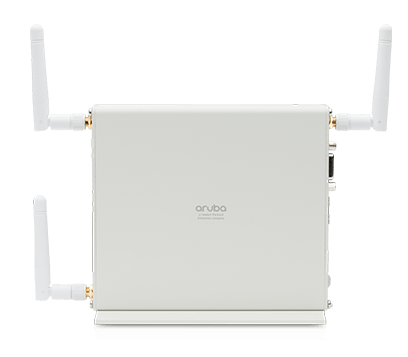
Aruba 501 Wireless Client Bridge
Extending Your Wireless Network Access

Click here to jump to more pricing!
Please Note: All Prices are Inclusive of GST
Overview:
The Aruba 501 Wireless Client Bridge enables you to easily integrate devices with no native wireless support into a wireless LAN (WLAN). It provides strong enterprise-class layered security features, including an IEEE 802.1X supplicant, to protect the network from intrusions.
The 501 Wireless Client Bridge can bridge up to 15 Ethernet client devices running a legacy networking protocol to the WLAN - extending wireless network access to a wide range of protocols. An integrated serial to TCP/IP converter enables a RS-232 asynchronous terminal device to communicate with a compatible station on the network. Hardware- accelerated encryption provides higher performance when using WPA2/AES security.
This bridge provides the benefits of wireless mobility for devices like electronic cash registers, scales, servers, printers, medical equipment and other devices. It can be deployed in any location where a WLAN signal is available - saving the time and expense of installing Ethernet cables for wired network access.
The 501 Wireless Client Bridge integrates into the Aruba Mobile First solution architecture and is interoperable with the IEEE 802.11a/b/g/n/ac wireless network infrastructure in a multi-vendor environment.
Highlights
- Link up to 15 Ethernet devices or an RS232 serial device to a wireless network at Gigabit speeds
- One dual-band three spatial-stream MIMO radio running up to 1.3 Gbps
- Support for IEEE 802.11b/g/n and 802.11a/n/ac WLAN networks
- Fast roaming between access points
- Web-based configuration
Benefits:
Quality of Service (QoS)
- Network management
- Support for DSCP and WMM
- SNMP v2c, SNMP v3, MIB-II with traps, and RADIUS authentication client MIB (RFC 2618)
- Embedded HTML management tool with secure access
- Scheduled configuration and firmware upgrades via a network management station
- Diagnostic
- RSSI logging
- Email alert tool
Connectivity
- IEEE 802.3af PoE support
- Simplifies deployment and dramatically reduces installation costs by helping eliminate the time and cost involved in supplying local power at each client bridge
- Auto-MDIX
- Provides automatic adjustments for straight-through or crossover cables on all 10/100/1000 ports
- IEEE 802.11h with International-Telecommunication-Union (ITU) compliance
- Selects the channel automatically, based on the access point it connects to; and avoids DFS (Dynamic- Frequency-Selection) issues by following the access point to a clear channel
Mobility
- Anywhere, anytime wireless coverage
- Provides single IEEE 802.11a/b/g/n/ac radio client bridge
- Offers radio software-selectable configuration of frequency bands
- Utilizes IEEE 802.3af PoE or local power supply
- Interoperability
- Meets Wi-Fi Alliance Certification standards, including IEEE 802.11a/b/g/n/ac and WPA2-to ensure multivendor interoperability
- Supported devices
- Support Windows-based PCs equipped with Ethernet cards; includes point-of-sale devices, scales, network printers, thin clients Mac/Apple machines, Linux/Unix workstations, Ethernet-enabled appliances, medical equipment, or manufacturing machinery
- Connects RS232 asynchronous terminal devices to the wireless network
- Multiple devices
- Connects up to 15 Ethernet-enabled devices via a multiport switch
Security
- IEEE 802.1X support
- Provides user authentication with support for EAP-TLS and PEAP-with choice of Advanced Encryption Standard (AES), Temporal Key Integrity Protocol (TKIP), and Wired Equivalent Privacy (WEP) encryption for protecting wireless traffic between authenticated clients and the access point
- Choice of IEEE, WPA2, WPA, or WEP
- Secures the data integrity of wireless traffic, using robust AES or TKIP encryption
Warranty and support
- Limited Lifetime Warranty
- Software releases To find software for your product, visit Aruba Support
Specifications:
| Aruba 501 Specifications | |
|---|---|
|
I/O ports and slots
Characteristics
Physical Characteristics
Environment
Electrical Characteristics
Regulatory
Regulatory Model Numbers
Security
|
Wireless Radio Specifications
Warranty and Support
Software Releases
|
Wireless Radio Specifications:
| RF Performance Table | ||
|---|---|---|
| Maximum transmit power (dBm) per transmit chain and includes the 2dBi dipole antenna that ships with the bridge | Receiver sensitivity (dBm) per receive chain and includes the 2dBi dipole antenna that ships with the bridge | |
|
802.11b 2.4 GHz |
||
|
1 Mbps |
21.0 |
-96.0 |
|
11 Mbps |
21.0 |
-88.0 |
|
802.11g 2.4 GHz and 802.11a 5 GHz |
||
|
6 Mbps |
20 (21 at 2.4 GHz) |
-92 (-93 at 2.4 GHz) |
|
54 Mbps |
19.0 |
-75.0 |
|
802.11n HT20 2.4 GHz and 5 GHz |
||
|
MCS0/8/16 |
18 (21 at 2.4 GHz) |
-90 (-93 at 2.4 GHz) |
|
MCS7/15/23 |
15 (16 at 2.4 GHz) |
-71.0 |
|
802.11n HT40 2.4 GHz and 5 GHz |
||
|
MCS0/8/16 |
20 (14 at 2.4 GHz) |
-90.0 |
|
MCS7/15/23 |
15 (14 at 2.4 GHz) |
-68.0 |
|
802.11ac VHT80 5 GHz |
||
|
MCS0 |
20.0 |
-86.0 |
|
MCS9 |
13.0 |
-59.0 |
Maximum capability of the hardware provided. Maximum transmit power is limited by local regulatory settings.
Documentation:
Pricing Notes:
- All Prices are Inclusive of GST
- Pricing and product availability subject to change without notice.
Our Price: Request a Quote
Our Price: Request a Quote
Our Price: Request a Quote
Our Price: Request a Quote
Our Price: Request a Quote
Our Price: Request a Quote
Our Price: Request a Quote

